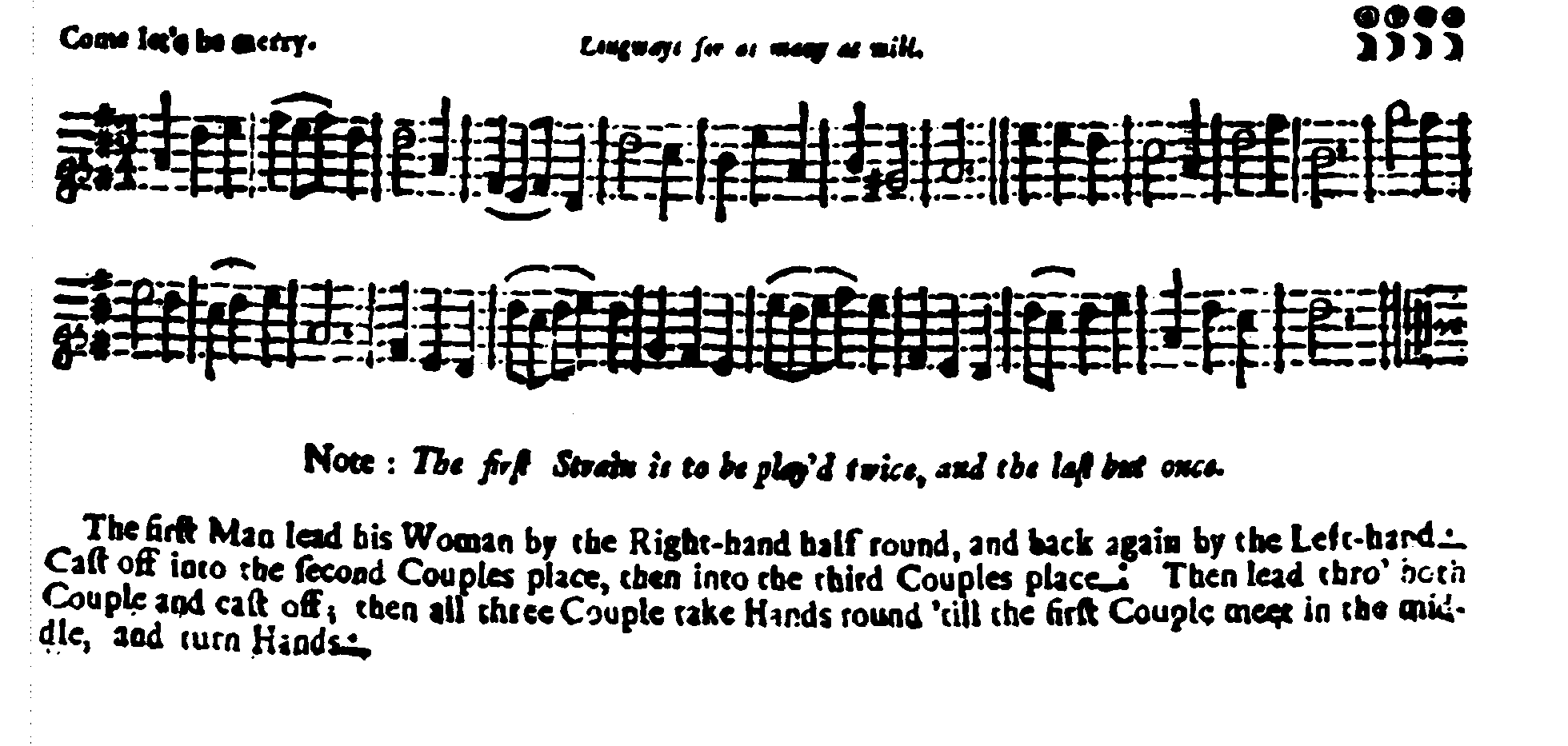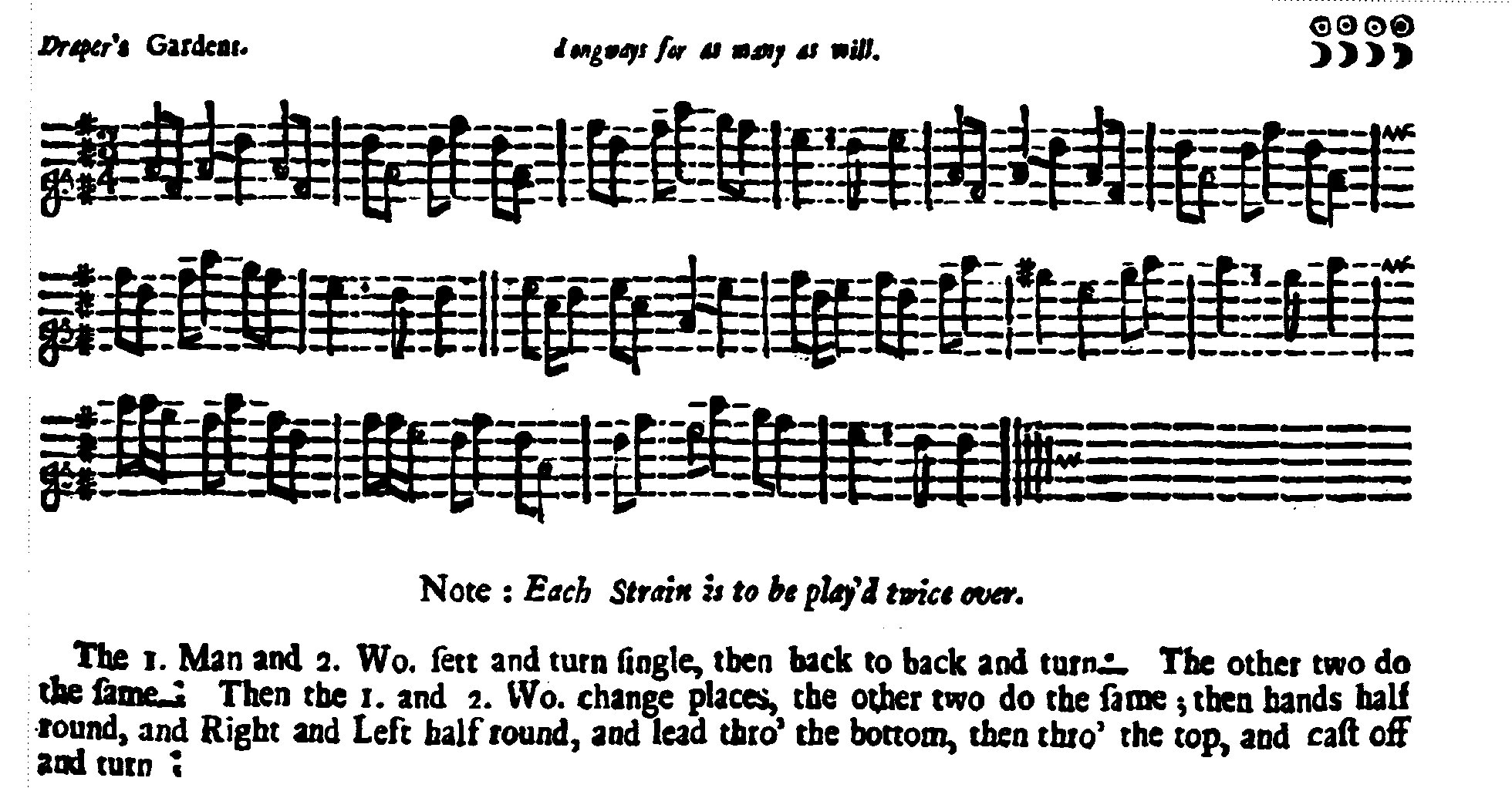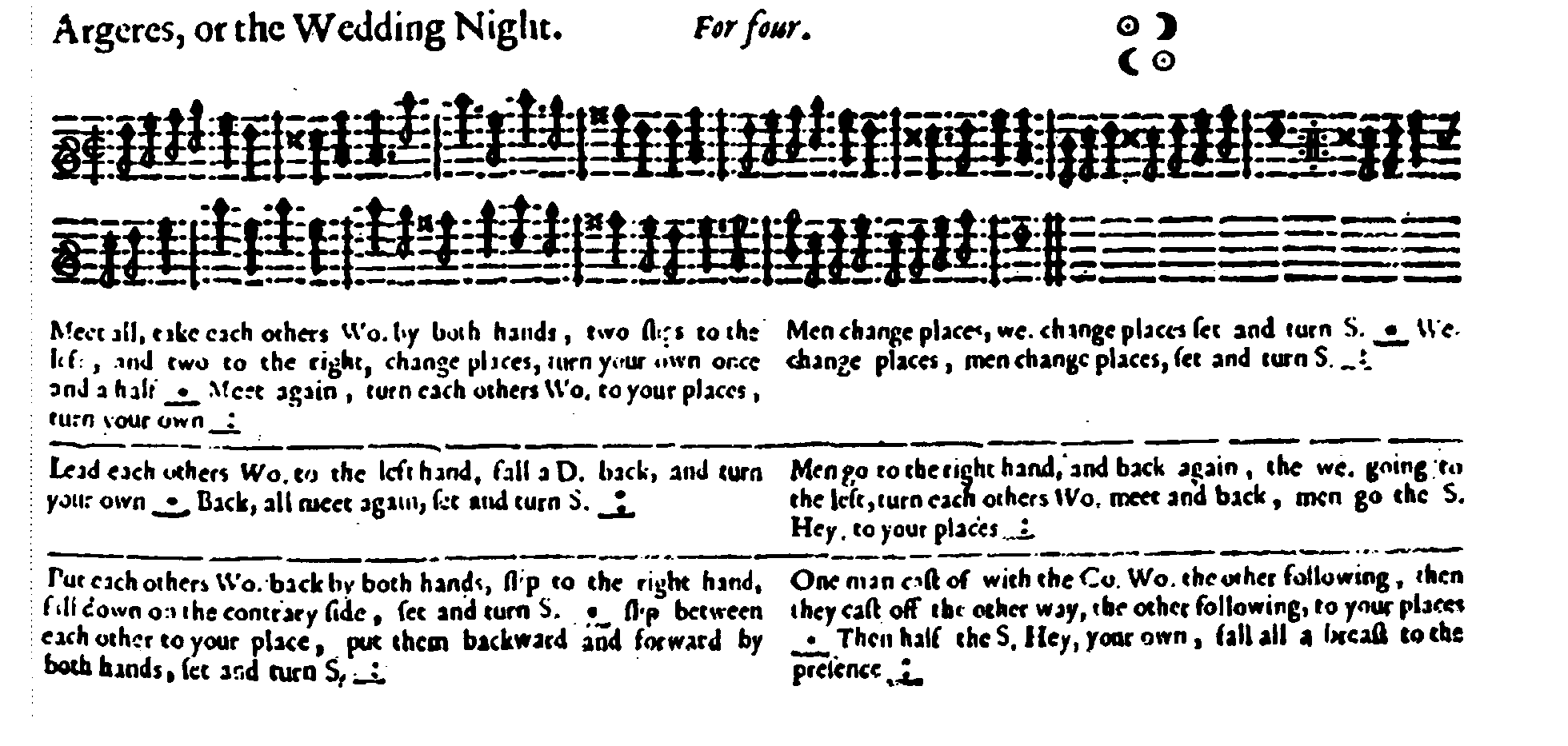
The Figures coding, "LCCLCOT," for the dance is described as follows:
Copies of all extant sources were obtained and data collected
from each dance. Variations in Title, Figures or the Music Incipit were
noted. After all dances had been coded, the Analysis field was used to
establish each unique dance. Examples of each unique dance were scanned
and edited for facsimile publication. This image is called the "Ur" dance
and is shown in each Ur dance record, along with other information on that
unique dance.
In addition to the usual information such as Title, Page Number, and Source Name and Date, each dance was analyzed for its basic Figures, or "track" and number of Active couples in the longways minor set.
Letters were selected to represent basic figures such as 0 for "circle", X for "hands across", and R for "right and left." These letters were then combined to represent the sequential figures of each dance. The codes provide an outline of the dance and help to bring like dances together in the indexes. (See Table 1 below for the coding letters used in the Figures field coding.)
Numbers were then added as "Comments" to provide clarification or additional information about the figures. These ranged from modifications such as "half-way," to step specifications such as "rigadoon" or "minuet." (See Table 2 below for the Comments code numbers.)
Examples of coding for three dances, "Come Let's Be Merry", "Draper's Gardens", and "Argiers", are shown below.
Details such as who is dancing with whom were not included,
nor have I tried to interpret such instructions as "Jingboys" or "Manulude."
This index is intended to be a research tool to provide access to the choreographies
of early English country dance. Although the basic pattern of each dance
is clear, dances cannot be accurately reconstructed from this streamlined
data. However, the images for each Ur dance can be used to interpret the
dance figures and music and the coded dance figures and comments will help
researchers find like items within the corpus of The Dancing Master.
The Form of the dance is coded using the following symbols:
| L | = Longways |
| R | = Round |
| S | = Set |
| Q | = sQuare |
| I | = lIne |
| W | = As many as Will |
| 2 | = Duple minor |
| 3 | = Triple minor |
| 4 | = 4 couple dance |
The number of "active" couples in the dance is shown in the Actives field.
| 1 | Swing | 51 | Turn off |
| 2 | Clap hands, Snap fingers | 52 | Contretemps |
| 3 | Stamp, Beat | 53 | Double Figure |
| 4 | Honor, Obeisance | 54 | Rigadoon |
| 5 | Kiss | 55 | Cross corners |
| 6 | Assemble | 56 | Foot it |
| 7 | Chain | 57 | Salute |
| 8 | Hook | 58 | Reel |
| 9 | Cast over | 59 | Backward |
| 10 | Boree Step | 60 | Jingboys |
| 11 | Pas de bas | 61 | Promenade |
| 12 | Waltz | 62 | Peep |
| 13 | Jig | 63 | Mullinet |
| 14 | Pirouette | 64 | Turn back hands |
| 15 | Couezi | 65 | Kick out legs |
| 16 | Serve hands | 66 | Hornpipe step |
| 17 | Cut off | 67 | Go without/within side |
| 18 | Fall | 68 | Minuet |
| 19 | Chassee, Chercee | 69 | Open,close |
| 20 | Slide, Slip | 70 | Cross partners |
| 21 | Coupee | 71 | Spring corners |
| 22 | Great Round | 72 | Draw |
| 23 | La Main | 73 | Link/Hook |
| 24 | Balance | 74 | Beckon |
| 25 | Dos a dos | 75 | Threaten |
| 26 | See Saw | 76 | Maze |
| 27 | Baulk | 77 | Lock hands |
| 28 | Leap, Jump, Hop | 78 | Allemand Passes |
| 29 | Dance | 79 | Make Honours |
| 30 | La Queux du Chat | 80 | Hold handkerchiefs to eyes |
| 31 | Ceremony | 81 | Meet all four corner ways |
| 32 | Observe | 82 | Shake/strike hands |
| 33 | March, Walk | 83 | Humour the tune, Look down & groan |
| 34 | Monk's March | 84 | Staggar as drunkard |
| 35 | Chassenet | 85 | Go behind/around |
| 36 | Manulude | 86 | Present & fire/Dart/Point Finger |
| 37 | Sesun | 87 | Make a feign |
| 38 | Pas de Bouree | 88 | Hit elbows |
| 39 | Brise, Breza | 89 | Feign a cry |
| 40 | Gallop | 90 | Double Triangles |
| 41 | Forward and back | 91 | Lead abreast |
| 42 | Go under hands | 92 | Turn backs |
| 43 | Olivette | 93 | Cut clean |
| 44 | Bow, Nod | 94 | Cross all four |
| 45 | Make your manners | 95 | Over the head |
| 46 | Change partners | 96 | Brush/Wind/Wave hands |
| 47 | Hunt | 97 | Cut capers |
| 48 | Shuffle | 98 | Shake legs |
| 49 | Pass through | 99 | Corrant Step |
| 50 | Cast in & out |
As an example, the dance "Come Let's be Merry" is shown below:Examples

The Figures coding, "LCCLCOT," for the dance is described
as follows:
| L | First man lead his woman round, and back again |
| C | Cast off into second couple's place |
| C | Cast into third couple's place |
| L | Lead through both couples |
| C | Cast off |
| O | Hands round |
| T | Turn hands |
Comments, "L=85/2,O/2," are described as:
| L=85/2 | Lead round (85 = round) half and back |
| O/2 | Hands round half |
Another dance, "Draper's Gardens," is shown below.

The Figures coding, "SNKTSNKTGGORLLCT," for the dance
is described as follows:
| S | Set | G | Change places |
| N | Turn Single | G | Change places |
| K | Back to back | O | Hands round |
| T | Turn | R | Right and Left |
| S | Set | L | Lead through bottom |
| N | Turn Single | L | Lead through top |
| K | Back to back | C | Cast off |
| T | Turn | T | Turn |
Comments, "O/2,R/2," are described as:
| O/2 | Half hands round |
| R/2 | Half right and left |
A third example, "Argiers," is a 3-section dance, with 2 sub-parts in each section:

The Figures coding, shown as: "LEGTLTT\GGSNGGSN\\LETLESN\LTLH\\
PLESNLPSN\CHTE", can be described as follows:
| 1st Section | \\ | 2nd Section | \\ | 3rd Section | |
| L | Meet i.e. Lead | L | Lead women | P | Put women i.e Pousette |
| E | Go out sides and back | E | Fall back | L | Slip i.e. Lead |
| G | Change places | T | Turn | E | Fall down outside |
| T | Turn | L | Lead | S | Set |
| L | Meet | E | Fall back | N | Turn single |
| T | Turn | S | Set | L | Slip between |
| T | Turn | N | Turn Single | P | Put back i.e. Pousette |
| \ | 2nd sub-part | \ | 2nd sub-part | S | Set |
| G | Change | L | Go to i.e. Lead | N | Turn single |
| G | Change | T | Turn | \ | 2nd sub-part |
| S | Set | L | Lead | C | Cast |
| N | Turn single | H | Hey | H | Hey |
| G | Change | T | Turn | ||
| G | Change | E | Fall | ||
| S | Set | ||||
| N | Turn single |
Comments, "L/2,E+20,E=18,P=72,L=20/2,H/2,E+91," can be
described as follows:
| L/2 | Lead up or down, but not back |
| E+20 | Slip out sides (20=slip) |
| P=72 | Pousette (72=pousette or draw) |
| L=20/2 | Slip up or down, not back |
| H/2 | Hey half way round |
| E=91 | Fall back abreast (91=abreast) |
Coding Procedures-Music
The Music incipits were originally coded in The National Tune Index: 18th-Century Secular Music, and imported from that database. The Music entries are coded using the scale degree of each note. Scale degree incipits use the numbers "1" through "7", representing "Do" through "Ti" in a major scale, with the following additional symbols: ("+" = Upper Octave; "-" = Lower Octave; "//" = Beginning of a full measure; "/" = rhythmic Stress Note within a measure). The Stress Notes field extracts the note after each "//" or "/". The Do field records the tonic base ("1" of the major scale). Time Signature and Key Signature were also recorded, although the actual music might not have matched these symbols. Music notation and spelling were not an exact science in the 17th and 18th centuries.
For more information on the Music coding and data collection programs, see The National Tune Index User's Guide 18th-Century Secular Music, listed in the Bibliography.
Music coding for the following example is shown below:

| SCALE DEGREE | 5-12//3231//15-//3-2-3-1-//17-//6-25- |
| STRESS NOTES | 531316 |
| DO | D |
| KEY SIGNATURE | FS,CS,FUS (F SHARP, C SHARP, F UPPER SHARP) |
| TIME SIGNATURE | 3/4 |